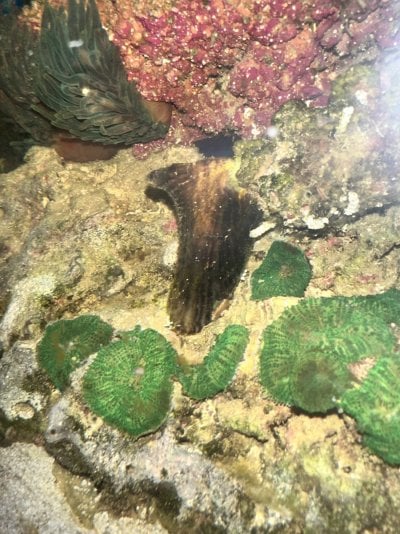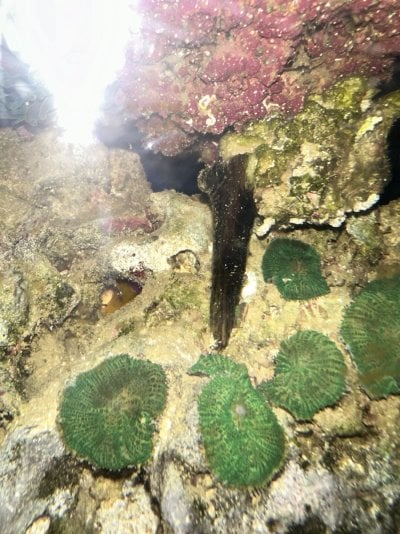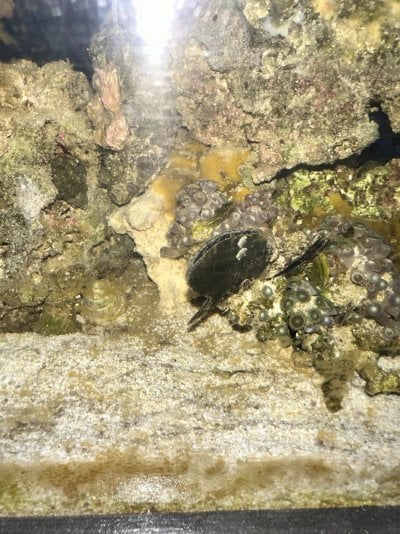Navigation
Install the app
How to install the app on iOS
Follow along with the video below to see how to install our site as a web app on your home screen.
Note: This feature may not be available in some browsers.
More options
You are using an out of date browser. It may not display this or other websites correctly.
You should upgrade or use an alternative browser.
You should upgrade or use an alternative browser.
Hitchhiker ID LARGE something!
- Thread starter SudzFD
- Start date
- Tagged users None
Some sort of bivalves
@ISpeakForTheSeas
@ISpeakForTheSeas
Yeah, looks like Pteria sp. oysters - neat!
I haven't seen these in a tank before, so I'm glad to see they're doing well for you. Have you been feeding any tiny foods like phyto?
I haven't seen these in a tank before, so I'm glad to see they're doing well for you. Have you been feeding any tiny foods like phyto?
Thank you so much! I think you are exactly right. It looks just like Pteria avicular. It sounds like they grow to 10 cm. Which would make two of the three close to full grown. They are very interesting looking.Yeah, looks like Pteria sp. oysters - neat!
I haven't seen these in a tank before, so I'm glad to see they're doing well for you. Have you been feeding any tiny foods like phyto?
I don’t feed phyto per se, but I do use coral frenzy from time to time and I have a small refugium which keeps a running supply of copepods into the display. I really appreciate you steering me to an ID.
vetteguy53081
Well known Member and monster tank lover
View Badges
Partner Member 2024
Excellence Award
Reef Tank 365
RGB
Article Contributor
Tampa Bay Reef Keepers
West Palm Beach Reefer
Hospitality Award
Ocala Reef Club Member
305 Reef Club
Wisco Reefers
Midwest Reefer
Fish Medic
MAC of SW Florida
Rock Pool Reef Keepers
R2R Secret Santa 2023
My Tank Thread
My Aquarium Showcase
This is a biValve often confused as a clam or oyster but is actually related to the scallop grouping, is a filter feeder and not very long lived. They are often found amongst wild caught zoas
I have multiple bivalves among my wild zoas, approaching a year with them in july, not what this looks like though, the one I have is not nearly as thinThis is a biValve often confused as a clam or oyster but is actually related to the scallop grouping, is a filter feeder and not very long lived. They are often found amongst wild caught zoas
This is a biValve often confused as a clam or oyster but is actually related to the scallop grouping, is a filter feeder and not very long lived. They are often found amongst wild caught zoas
Interesting the distinction you are making here. I think this "winged oyster" is in the same grouping as a pearl oyster, and in fact they can also produce pearls. I guess I thought of it as different to both, common oysters (that you eat) and scallops.
The distinction is inaccurate, and this oyster is different from the oysters like you eat and from scallops.Interesting the distinction you are making here. I think this "winged oyster" is in the same grouping as a pearl oyster, and in fact they can also produce pearls. I guess I thought of it as different to both, common oysters (that you eat) and scallops.
Bivalves are all creatures in the taxonomic class Bivalvia; all clams, oysters, mussels, scallops, cockles, etc. are bivalves differentiated by lower taxonomic classifications.
For example, the Pacific Oyster, Magallana gigas (formerly known as Crassostrea gigas), first differs from the Swift Wing Oyster, Pteria avicular, at the taxonomic superfamily level.
For comparison to help put that gap superfamily level gap into perspective, humans differ from baboons and macaques at the same level (Hominoidea for humans and Cercopithecoidea for baboons).
The difference between scallops and these oysters is one step higher taxonomically, with scallops being from the taxonomic order Pectinida and these oysters coming from Ostreida.
At the order level, the difference would be between humans and colugos/flying lemurs.
The first one I ever saw was very small amongst the zoa colony. So that makes sense too on where it came from. Thanks!I have multiple bivalves among my wild zoas, approaching a year with them in july, not what this looks like though, the one I have is not nearly as thin
Similar threads
- Replies
- 7
- Views
- 252
- Replies
- 13
- Views
- 229
- Replies
- 3
- Views
- 466




















